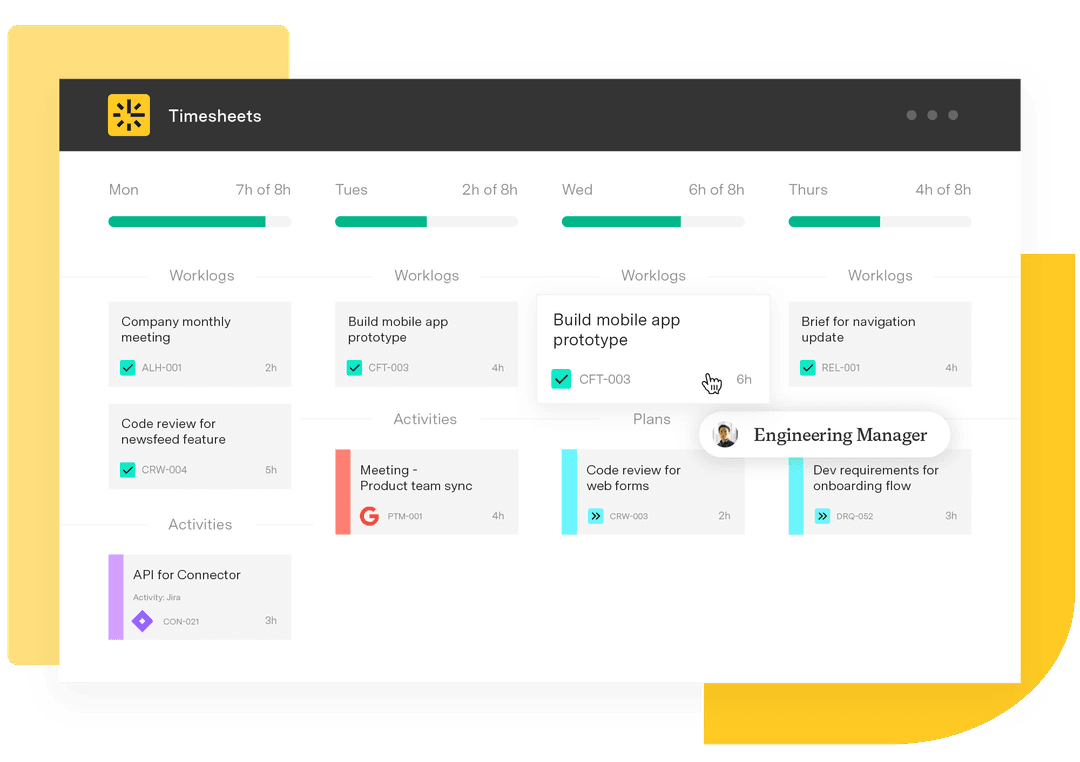Regain your focus: Strategies to prevent context switching
Tempo Team
Sometimes, the problem isn’t that you have too much work, but that switching between multiple tasks drains your focus and leaves you wondering where the day went.
This guide unpacks what context switching is, why it’s so common in modern workplaces, and how it erodes productivity. We’ll also share practical strategies for protecting your attention and keeping your tasks on schedule.
What’s context switching?
Context switching is when you shift your attention from one area of focus to another. For example, you might move to Slack to answer a message while writing a report or toggle between tabs while researching.
While context switching may feel like multitasking or keeping up with your workload, the reality is that every time you change focus, your brain has to adjust; it leaves behind the mental framework of one process and loads a new one. The focus lost in this shift is what is known as “attention residue,” and that lag in adjustment, however brief, compounds. Instead of getting more done, you spend time catching up with yourself.
Frequent context switching saps your mental energy and ultimately reduces the quality of your work. Over time, constant gear-shifting leads to cognitive fatigue, which makes thinking clearly or making decisions difficult. Small context switches, like reading a message preview for something unrelated while in the middle of deep work, can derail your concentration more than you think.
Why do people context switch?
Context switching is built into how modern teams work. From communication tools to project structures, many workplace norms encourage task-hopping. Here are some of the most common causes.
Digital overload
Most workers juggle dozens of platforms every day, including email, chat apps, notifications, and cloud-based tools. The volume of tools and the constant inflow of pings and updates disrupts focus. Even glances at a new message or alert can derail concentration and increase the time it takes to return to meaningful work.
Interrupt-driven culture
Many teams operate with the expectation of immediate response, whether it’s answering a chat within minutes or jumping on impromptu calls. This kind of interrupt culture makes protecting stretches of uninterrupted time difficult. When responsiveness becomes the norm, focus takes a back seat.
Poor prioritization
Without set priorities, everything feels urgent. This leads to jumping between multiple tasks as they arise instead of following a plan, and the mental effort to reassess what’s important can be draining.
Lack of dedicated focus time
Few calendars leave room for deep work. Meetings often fill the day in fragments, with little space for tasks requiring sustained attention. Context switching becomes inevitable when work gets squeezed into the margins between calls.
Unstructured project workflows
When tasks lack structure, including unclear ownership or vague timelines, people jump between responsibilities just to stay afloat. It’s easy to fall into a loop of pivoting between partial tasks without visibility into what needs to be done and when.
What's the difference between context switching and multitasking?
Context switching and multitasking are often used interchangeably, but they’re not the same thing. Both can disrupt focus and drain mental energy, but they do it differently.
Context switching is moving from one task to another, like writing an email while jumping into a meeting, or reviewing a spreadsheet while taking a call. You’re not doing these things simultaneously, but constantly shifting forces your brain to repeatedly reset. That reset takes effort, even if it feels automatic.
Multitasking is when you try to do two or more things simultaneously, like responding to messages during a video call or editing a document while listening to a podcast. It splits your attention, reducing the quality of thinking applied to any task.
In both cases, your brain struggles to perform at its best. But where multitasking dilutes focus, context switching breaks it altogether. Understanding the difference helps identify what kind of disruption you’re dealing with and how to reduce it.
7 ways to combat context switching
Reducing context switching for productivity protects your attention. These strategies help create the conditions for focused, efficient work.
1. Time block focused work
Time blocking reduces the chance of disruption during critical periods. Cognitive science shows that attention takes 15 to 20 minutes of uninterrupted work to reach a flow state, however, minor distractions during this buildup can reset the clock. Set aside specific windows in your calendar for uninterrupted work. Treat these blocks as non-negotiable, just like meetings.
2. Use task batching
Group similar tasks together and tackle them in a single session. For example, you could answer all emails at once instead of checking your inbox throughout the day. Batching reduces the number of transitions your brain has to make, which helps preserve focus.
Recent research shows that similar tasks share cognitive context, meaning your brain doesn’t need to reload entirely new mental models between them. This keeps you in the same task schema and minimizes performance loss.
3. Prioritize your to-do list
People are more likely to complete important tasks when they're ranked clearly and started early, before decision fatigue sets in. To that end, try to start each day by identifying your top priorities, then complete high-impact tasks before switching to lower-priority items. This helps avoid reactive work patterns and keeps your attention aligned with your goals.
4. Limit open browser tabs or apps
Keeping too many tabs or tools open invites distraction. Each one is a mental breadcrumb that pulls your attention down a different path. Close what you don’t need, and only open tools relevant to your current task.
Browser tab clutter has been linked to anxiety and lowered task accuracy, especially under time pressure. Each visible tab cues your working memory, consciously or not, creating micro-distractions and draining cognitive load.
5. Turn off non-essential notifications
Silence alerts that don’t require immediate action. This includes social media and chat pings. Fewer interruptions means fewer breaks in your cognitive flow. The presence of your smartphone and notifications, even if ignored, disrupts attention by triggering what’s known as an “orienting response” in the brain.
6. Set expectations with your team
If your work requires focus time, let others know when you're unavailable for instant responses. Creating shared norms around response time helps shift the culture away from constant availability and toward less context shifting.
7. Use a single source of truth for work
Switching between tasks and deadlines becomes a strain on your attention if your goals and deadlines are scattered across tools. When tasks, messages, and project details are scattered across apps, employees spend too much time looking for information. Productivity studies show workers often waste hours a week hunting through multiple platforms to track down what they need. Centralizing information helps people get on with the work.
Minimize context switching in Jira with Tempo
One of the most effective ways to reduce context switching is to centralize where and how work gets done. Tempo’s suite of Jira-native tools helps teams bring planning, tracking, and reporting into a single, connected workspace.
Tempo Timesheets streamlines time tracking directly within Jira. Instead of jumping between separate tools to log hours or review reports, teams can see where their time is going without leaving their workflow.
Custom Charts for Jira adds flexible reporting that’s easy to read and configure. Teams can visualize progress and performance within the same environment where they manage tasks, cutting down on tool-hopping.
Using Tempo tools to consolidate time tracking and reporting, teams can stay focused and minimize the mental cost of context shifting throughout the day.














































